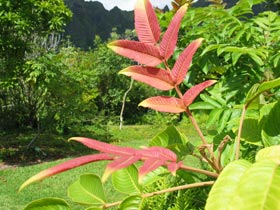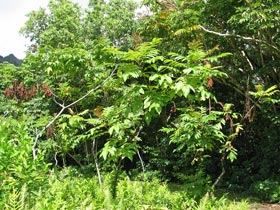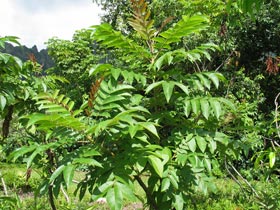Rhus sandwicensis
Genus
Rhus
Species
sandwicensis
Hawaiian Names with Diacritics
- Neleau
- Neneleau
Hawaiian Names
- Neleau
- Neneleau
Common Names
- Hawaiian sumac
Synonyms
- Rhus chinensis var. sandwicensis
- Rhus semialata var. sandwicensis
Distribution Status
Endemic
Endangered Species Status
No Status
Plant Form / Growth Habit
- Shrub
- Tree
Mature Size, Height (in feet)
- Shrub, Medium, 6 to 10
- Shrub, Tall, Greater than 10
- Tree, Small, 15 to 30
Life Span
Long lived (Greater than 5 years)
Landscape Uses
- Accent
- Screening
Additional Landscape Use Information
Plants produce numerous root suckers and can become troublesome if planted near planting beds or areas where it is not welcomed.
Does well as a hedge or as a screen from roads.
Plant Produces Flowers
Yes
Flower Type
Showy
Flower Colors
- Brownish
- Red
- White
Additional Flower Color Information
Whitish flowers with reddish brown fuzz (tomentose) are displayed in dense bunches.
Additional Blooming Period and Fruiting Information
Small round red fruits (drupes) about 1/8 inch (3 mm) in diameter are produced in abundance.
Plant texture
- Coarse
Additional Plant Texture Information
The leaves are green on the upper surface and paler on the lower surface. Leaves have a reddish tinge to them when they are younger.
Leaf Colors
- Light Green
- Medium Green
Additional Leaf Color Information
The new leaves (liko) are the most striking features of neleau. The colors can range from light pink, to mauve, orangish, bright red, brick red, to magenta and all shades in between. Older leaves are light to dark green.
Additional Pest & Disease Information
Ants can be a nuisance. Weeds at base of plants should be controlled.
Pruning Information
Neleau can form dense stands and may require pruning to control. The root suckers can come up in unwanted areas.
Water Requirements
- Moist
Additional Water Information
Neleau can be grown in dry to wet conditions.
Soil must be well drained
Yes
Light Conditions
- Full sun
- Partial sun
Natural Range
- Kauaʻi
- Oʻahu
- Molokaʻi
- Maui
- Hawaiʻi
Natural Zones (Elevation in feet, Rainfall in inches)
- 150 to 1000, 0 to 50 (Dry)
- 150 to 1000, 50 to 100 (Mesic)
- 150 to 1000, Greater than 100 (Wet)
- 1000 to 1999, 0 to 50 (Dry)
- 1000 to 1999, 50 to 100 (Mesic)
- 1000 to 1999, Greater than 100 (Wet)
- 2000 to 2999, 0 to 50 (Dry)
- 2000 to 2999, 50 to 100 (Mesic)
- 2000 to 2999, Greater than 100 (Wet)
- 3000 to 3999, 0 to 50 (Dry)
- 3000 to 3999, 50 to 100 (Mesic)
- 3000 to 3999, Greater than 100 (Wet)
- 4000 to 4999, 0 to 50 (Dry)
- 4000 to 4999, 50 to 100 (Mesic)
- 4000 to 4999, Greater than 100 (Wet)
Habitat
- Terrestrial
Additional Habitat Information
Neleau is found in scattered locations throughout its range and most common near Hilo and Waimea (Kamuela) on Hawaiʻi Island from around 500 to over 7,000 feet.
On Kauaʻi, neleau can be seen at Makaweli, and Kamaliʻi Ridge; on Oʻahu, at Nuʻuanu and Moanalua valleys, and at Hoʻomaluhia; and on Molokaʻi, in Pelekunu Valley.
![]() Special Features and Information
Special Features and Information
General Information
Neleau (Rhus sandwicensis) belongs to the Mango or Cashew family (Anacardiaceae). This is the only member native and endemic to the Hawaiian Islands.
Some well known edible kin include mango (Mangifera spp.), cashew (Anacardium occidentale), and pistachio (Pistachia vera). The highly invasive Christmas berry (Schinus terebinthifolius) is on the family list as well.
The family also has some unsavory characters in aptly named genus Toxicodendron, meaning "poison tree," and they include poison-ivy, poison-oak, and poison sumac--the latter is perhaps the most toxic plant in the United States.
Etymology
The generic name Rhus is derived from rhous, the Greek name for sumac.
The species name sandwicensis refers to the "Sandwich Islands," as the Hawaiian Islands were once called, and named by James Cook on one of his voyages in the 1770's. James Cook named the islands after John Montagu (The fourth Earl of Sandwich) for supporting Cook's voyages.
Background Information
Bruce Bohm, botanist, notes that neleau (Rhus sandwicensis) "does not produce the phenolic compounds typical of its toxic cousins." Bohm goes on to say that "people to whom I have spoken have never experienced skin problems when handling the plant, and I did not have any reaction when I handled it (I have been sensitized to poison oak, but do not react to mangoes or lacquer ware)." [4]
The fruits are reported to be edible. [3]
Early Hawaiian Use
Neleau was used in making calabashes. [2]
Modern Use
Neleau is one of the few native plants that re-colonize old [sugar] cane fields and waste lands at low elevations. [J.B. Friday, College of Tropical Agriculture and Human Resources, Hilo, Hawaiʻi]
The light but tough yellowish-gray wood of neleau was once used as saddle trees on ranches and to make plows and yokes for oxen by ranchers. [1,3] The wood is described as yellowish-gray with dark resinous streaks, light weight, coarse-textured, and tough. [3]
The bark was formerly used in tanning goat skins in Hawaiʻi. [3]
Additional References
[1] "The Indigenous Trees of the Hawaiian Islands" by J.F. Rock, page 263.
[2] "Auwahi: Ethnobotany of a Hawaiian Dryland Forest" by A.C. Medeiros, C.F. Davenport & C.G. Chimera, page 15.
[3] "Common Forest Trees of Hawaii (Native and Introduced)" by Elbert L. Little Jr. and Roger G. Skolmen, page 194.
[4] "Floridata, Hawaiian Plants" by Bruce Bohm http://www.floridata.com/tracks/bruce/hi/Amaranthaceae_Anacardiaceae.cfm [Accessed 03/13/12]
PHOTOS FOR THIS SPECIES CAN BE SEEN AT THE LINK (Copy & Paste to your browser):
https://www.flickr.com/search/?user_id=50823119%40N08&sort=date-taken-desc&view_all=1&text=Rhus%20sandwicensis
Plant Gallery
Back to Plant List
Other Nursery Profiles for Rhus sandwicensis



